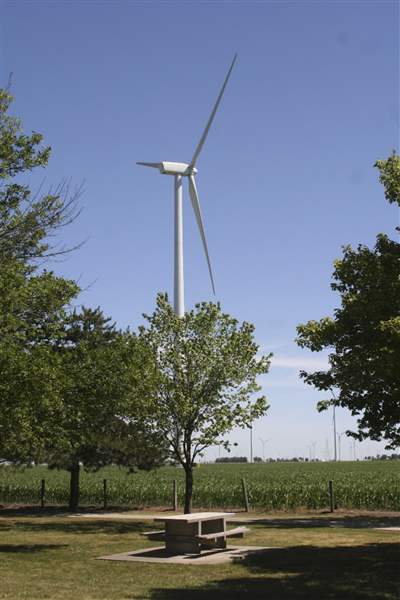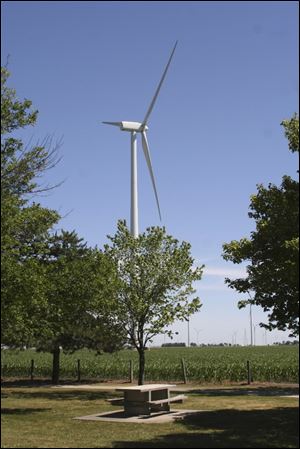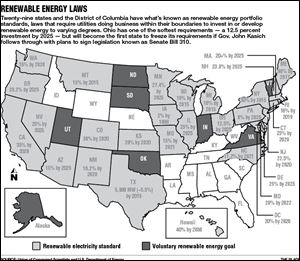
RENEWABLE ENERGY
Pair of bills could sour businesses on Ohio
Firms say they’ll expand elsewhere
6/8/2014
Only 12 of the 152 wind turbines in the wind farm in Van Wert and Paulding counties would have been built if House Bill 483 was in place three years ago.
COLUMBUS DISPATCH/STEVE STEPHENS

Only 12 of the 152 wind turbines in the wind farm in Van Wert and Paulding counties would have been built if House Bill 483 was in place three years ago.
Two bills that Gov. John Kasich is expected to sign into law this week have major ramifications for how future electricity will be generated in Ohio.
Both will deflate Ohio job markets in the renewable energy sector — especially in northwest Ohio because of how it has embraced that technology, critics predict.
The governor’s decisions will have a ripple effect on the national debate over renewable energy, they said, although adding that they are uncertain if it will set the stage for widening the debate in other states or simply shift business that Ohio could have had to them. Either way, they said, the latter is a given.
Senate Bill 310 calls for a two-year freeze on Ohio’s renewable energy law that was created by a near-unanimous vote of the Ohio General Assembly in 2008. It requires utilities doing business in Ohio to get at least 12.5 percent of their electricity from renewable energy sources by 2025, whether they develop them on their own or invest in them. It also calls for more energy efficiency.
Freezing that law, even for a short time, sends out a message that Ohio is no longer receptive to renewable energy investments — a reputation that will be hard to shake even if the freeze is lifted in 2016, advocates said.
“A lot of us assume it won’t be restarted,” said Bill Spratley, Green Energy Ohio executive director and former Ohio Office of Consumer Counsel director.

Wind power
House Bill 483 is seen as a bigger attack on one of the fastest-growing sources of renewable energy, wind power.
It calls for unprecedented setbacks for massive, commercial-scale wind turbines.
Only 12 of the 152 wind turbines in the Blue Creek Wind Farm in Van Wert and Paulding counties — which cost $600 million and was the largest single business investment in Ohio when it was erected in 2011 — would have been built if those setback requirements were in place three years ago, said Dan Litchfield, Chicago business developer for Iberdrola Renewables, an international company in Spain which did that project. (A setback is the distance required between the property line and the turbine.)
Mr. Litchfield, who grew up in Ohio, said he persuaded his bosses at Iberdrola to invest in the Buckeye State because of incentives offered under Ohio’s renewable energy law.
The company had been considering Indiana.
Now, Iberdrola will have to strongly consider taking its plans for two more major wind projects in northwest Ohio to another state if Mr. Kasich signs those pieces of legislation into law, Mr. Litchfield said.
One plan calls for an additional 50 turbines in Van Wert County; the other calls for 75 turbines in Putnam County, he said.
The existing turbines would be grandfathered in under the setback legislation.
According to the Washington-based American Wind Energy Association, Ohio now has 62 factories manufacturing parts for the wind energy.
That’s No. 1 in America, Peter Kelley, association spokesman, said.
“We wanted to keep growing in Ohio,” Mr. Kelley said. “Clearly, there’s a lost opportunity there.”
Eric Thumma, Iberdrola director of policy and regulatory affairs in Boston, said House Bill 483 “puts us out of business.”
“We rushed enthusiastically into Ohio,” Mr. Thumma said. “We would be more cautious [if it is signed into law].”
The Blue Creek Wind Farm generates approximately $1.1 million in lease payments for northwest Ohio farmers, as well as money for local school districts in the form of additional property tax revenue.
Many farmers see the proposed setback requirements as an affront to their private property rights, Dale Arnold, Ohio Farm Bureau energy policy director, said.
“What science, what evaluation, what discussion has gone into this?” he asked. “We’re concerned many of those [setback requirements] are arbitrary.”
Other effects
The two laws on Mr. Kasich’s desk aren’t just about wind turbines, nor do they just affect rural areas.
One of metro Toledo’s oldest and largest businesses, Rudolph/Libbe, has remade itself because of the nation’s budding interest in solar power.
Rudolph/Libbe went from virtually no involvement in solar projects to generating 10 percent of its revenue from them within five years after Ohio’s renewable energy law took effect in early 2009.
The company came from nowhere to be ranked by a trade journal, Solar Power World, one of America’s Top 50 commercial solar contractors for 2013.
Jason Slattery, Rudolph/Libbe director of solar, said costs have come down rapidly because economies of scale have improved.
Solar-installation projects cost Rudolph/Libbe only 25 percent of what they cost the company five years ago, he said.
A freeze will force the company to seek more installation contracts in other states, resulting in fewer Ohio jobs and more elsewhere, Mr. Slattery said.
“We think that will take projects from Ohio and will move them to states that embrace them,” Mr. Slattery said. “Investors want stability and confidence. That’s the challenge we have with S.B. 310. It doesn’t give them either.”
He said Rudolph/Libbe is “bullish on Michigan,” where investments in renewable power remain strong.
“We’re going to continue to grow,” Mr. Slattery said. “Unfortunately, it’ll probably not be in Ohio. It’ll be in states that continue to have stable [renewable energy] laws.”
Ohio is one of 29 states, along with the District of Columbia, that have renewable energy portfolio standards.
Those are laws that require utilities doing business within their boundaries to invest in or develop renewable energy to varying degrees.
According to U.S. Department of Energy data, Ohio has some of the softer requirements.
It will become the first state to freeze its requirements if Mr. Kasich signs Senate Bill 310 into law.
“I don’t expect other states to follow, but I expect it to hurt the development of green energy in Ohio,” Mr. Spratley said.
The governor has stated his intent to sign that bill and the one pertaining to setbacks for wind turbines.
A ‘timeout’
The main push for the freeze has come from utilities, especially FirstEnergy Corp. of Akron, which is heavily invested in coal-fired power and has said that Ohio’s renewable energy law has been too restrictive.
“We’ve been fairly clear and consistent in our position,” Doug Colafella, FirstEnergy spokesman, said.
He said the utility does not expect lingering effects of Mr. Kasich’s decision. He said Senate Bill 310 allows Ohio to pick up where it left off in 2016, unless more legislation is passed to repeal, slow down, or further delay the state’s renewable energy law.
“We see this more as a two-year timeout,” he said.
FirstEnergy believes Ohio customers will be socked with higher monthly electric bills — as much as 350 percent more in 2025 over current levels — if the state continues of its current path, Mr. Colafella said.
But Ohio utilities have filed reports with the Public Utilities Commission of Ohio showing mandated energy-efficiency programs will yield more than $4.1 billion in savings over the program’s life, according to Ohio Advanced Energy Economy.
Ted Ford, Ohio Advanced Energy Economy president and chief executive officer, has said numbers generated by utilities themselves “demonstrate that on average, every dollar that has been spent on energy-efficiency programs has resulted in two dollars in savings for Ohio consumers.”
Utilities maintain their support for a freeze even after President Obama dropped a policy bombshell on Monday, an announcement that he will seek up to a 30 percent reduction in emissions from coal-fired power plants by 2030 to help combat climate change.
That is expected to open up new markets for natural gas, renewable energy, and energy-efficiency programs nationally.
Critics of the freeze claim Ohio will be left on the sidelines for all but natural gas if Mr. Kasich signs Senate Bill 310.
Ray Evans, FirstEnergy vice president of environmental and technologies, has said he does not see major compliance challenges with the Obama plan.
The opposition
Those voicing objections to a freeze go beyond predictable environmental groups.
They include members of Ohio’s faith community, as well as some of Ohio’s largest businesses.
Fifty-one companies urged Mr. Kasich to veto Senate Bill 310 in a letter last week.
They include Toledo’s Owens Corning and other major employers, such as Whirlpool, Honda, Campbell Soup Co., Johnson Controls Inc., First Solar, Honeywell, Nissin Brake Ohio, and Husky Energy.
Whirlpool said Ohio’s renewable energy law “has proven to be a cost-effective policy that not only helps Ohio businesses and consumers with energy-efficiency projects but also helps reduce wholesale energy prices for all Ohio customers,” said Kristine Vernier, Whirlpool senior manager for global public relations.
The Ohio Chamber of Commerce sides with utilities and supports a two-year freeze.
The Ohio Manufacturers Association agrees with companies calling for a veto.
Contact Tom Henry at: thenry@theblade.com or 419-724-6079.